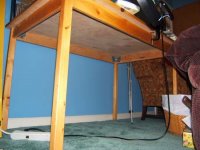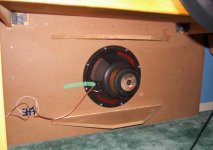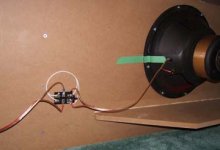OK, maybe this isn't the only OB thread in the subwoofer forum. But this thread could be in Multi-Way (with most of the OB threads) or Planar (where the folks just love OB sound).
I've always been dismayed over boxed sound but you can't fight the laws of physics when it comes to long-wave cancellation, esp. when aiming for output in the 30-110 Hz range. But where do you hide a 5 foot diameter board?
Of immediate research interest to me was controlling room modes. Seemed to me that about the best you could do to fight room modes is OB with a large expanse of outlet along a wall and doubly so, if you were adding that to a corner Klipschorn.
A lot of folks follow the logic of Linkowitz. They build tiny baffles that start eating the waves above the speaker's range. Odd? Then they use a simple EQ network to move the cone progressively more far enough at declining frequencies to compensate for the cancellation. This demands several inches of excursion at lowest frequencies. The electronic circuitry is simple, but the demands on the drivers are ridiculous - a case of the tail wagging the dog.
Soooo, I had a table in my music room. Below is what it looks like underneath.
... and I installed a speaker facing the wall. See picture. The driver is a 1967 Stephens Trusonic 150W, 15 inches, free air resonance around 20 Hz, 2.5 lbs of alnico magnet. I have a few sparse parameters, if anybody is interested. The best of that era, but I wonder about today?
It is hard to describe the shape of the baffle board and total distance from the front of the driver to the back. The front of the driver faces the room wall from about 3 inches - so maybe there is a bit of front loading. Think in terms of a circle, then very roughly:
1. 145 degrees shoved tightly into the carpet... no sound getting through there.
2. 70 degrees (at the left and right sides) are to the edges of the 60 inch baffle board; so the sound has a path of about 60-65 inches.
3. 145 degrees (upwards to the top of the board) means the sound has to go up the baffle board and then across the width of the table top moving from the wall, and then under the table top to the driver's rear, about 65-75 inches.
None of those dimensions are constant curves, as you can see. That beneficially smears the path lengths and the interaction with the room.
Results: with 5-10 db of "tone control" and "loudness" boost at 50 Hz, sounds pretty good. Organ music very nice indeed, maybe "airy", although, paradoxically, it doesn't demand the lowest freq. from the speaker for perceiving the pedals, just for feeling them. Falls short of what I am used to on large bass drums, see Signature. My sense, using my ancient bass sweep tone, is that the speaker rolls off from maybe 60 Hz which I'd characterize as the place where the OB cancellation starts to bite. Glad to hear from the simulators out there what it ought to sound like.
Yes, does a pretty nice job smoothing room resonances on its own. When I add the Klipsch back in, some of the hills-and-valleys are back. Maybe I'll need to run the Klipsch, AR, and OB to have low freq. as well as smooth room response.
Interesting discovery, OBs shake at low frequencies, even when the whole "speaker" assembly weighs around 100+ lbs. You need cinder blocks or attaching it to the building structure. In that way it is different from other enclosures. Ever think of that? I wonder why I never read that before... maybe few people have tried to get seriously low freq. from a stand-alone OB. Very low frequencies might be helped if I anchor or weigh-down the speaker; obvious challenges there.
Preliminary final thoughts. The sound is nice, just as the Planar crowd say,although "nice" is a hard term to apply to the rudimentary requirements of good bass. Room modes nicely wrangled. In the long run, I am not sure a high sub-woofer (with weak sub-40 Hz content) helps my system.
I've always been dismayed over boxed sound but you can't fight the laws of physics when it comes to long-wave cancellation, esp. when aiming for output in the 30-110 Hz range. But where do you hide a 5 foot diameter board?
Of immediate research interest to me was controlling room modes. Seemed to me that about the best you could do to fight room modes is OB with a large expanse of outlet along a wall and doubly so, if you were adding that to a corner Klipschorn.
A lot of folks follow the logic of Linkowitz. They build tiny baffles that start eating the waves above the speaker's range. Odd? Then they use a simple EQ network to move the cone progressively more far enough at declining frequencies to compensate for the cancellation. This demands several inches of excursion at lowest frequencies. The electronic circuitry is simple, but the demands on the drivers are ridiculous - a case of the tail wagging the dog.
Soooo, I had a table in my music room. Below is what it looks like underneath.
... and I installed a speaker facing the wall. See picture. The driver is a 1967 Stephens Trusonic 150W, 15 inches, free air resonance around 20 Hz, 2.5 lbs of alnico magnet. I have a few sparse parameters, if anybody is interested. The best of that era, but I wonder about today?
It is hard to describe the shape of the baffle board and total distance from the front of the driver to the back. The front of the driver faces the room wall from about 3 inches - so maybe there is a bit of front loading. Think in terms of a circle, then very roughly:
1. 145 degrees shoved tightly into the carpet... no sound getting through there.
2. 70 degrees (at the left and right sides) are to the edges of the 60 inch baffle board; so the sound has a path of about 60-65 inches.
3. 145 degrees (upwards to the top of the board) means the sound has to go up the baffle board and then across the width of the table top moving from the wall, and then under the table top to the driver's rear, about 65-75 inches.
None of those dimensions are constant curves, as you can see. That beneficially smears the path lengths and the interaction with the room.
Results: with 5-10 db of "tone control" and "loudness" boost at 50 Hz, sounds pretty good. Organ music very nice indeed, maybe "airy", although, paradoxically, it doesn't demand the lowest freq. from the speaker for perceiving the pedals, just for feeling them. Falls short of what I am used to on large bass drums, see Signature. My sense, using my ancient bass sweep tone, is that the speaker rolls off from maybe 60 Hz which I'd characterize as the place where the OB cancellation starts to bite. Glad to hear from the simulators out there what it ought to sound like.
Yes, does a pretty nice job smoothing room resonances on its own. When I add the Klipsch back in, some of the hills-and-valleys are back. Maybe I'll need to run the Klipsch, AR, and OB to have low freq. as well as smooth room response.
Interesting discovery, OBs shake at low frequencies, even when the whole "speaker" assembly weighs around 100+ lbs. You need cinder blocks or attaching it to the building structure. In that way it is different from other enclosures. Ever think of that? I wonder why I never read that before... maybe few people have tried to get seriously low freq. from a stand-alone OB. Very low frequencies might be helped if I anchor or weigh-down the speaker; obvious challenges there.
Preliminary final thoughts. The sound is nice, just as the Planar crowd say,although "nice" is a hard term to apply to the rudimentary requirements of good bass. Room modes nicely wrangled. In the long run, I am not sure a high sub-woofer (with weak sub-40 Hz content) helps my system.
Attachments
Last edited:
Hi bentoronto,
could you please make a sketch showing the
dimensions and distances to the walls ?
Position of the whole assembly in the room ?
It seems that you are heavily mass loading the
driver in proximity to the wall and facing the wall.
And the driver has already far too low free air
resonance.
Doesn't look like a killer in efficiency ...
Making use of wall proximity is different with OB's
i guess ...
---
If you want to have some fun with the old table
- make the drivers cutout near the corner of the table top
(and close the current cutout)
- place the table top upright, the long edge as airtight as possible
aligned with a side wall (e.g. blankets as a gasket).
- the driver in the edge of the room between side wall and bottom
- the radiation axis (orthogonal to the table top) pointing in
parallel to the longest dimension of the room
- then play with the distance to the next corner in the room
(> 1,2m) and move the assembly along the edge until something
of interest happens.
Kind Regards
could you please make a sketch showing the
dimensions and distances to the walls ?
Position of the whole assembly in the room ?
It seems that you are heavily mass loading the
driver in proximity to the wall and facing the wall.
And the driver has already far too low free air
resonance.
Doesn't look like a killer in efficiency ...
Making use of wall proximity is different with OB's
i guess ...
---
If you want to have some fun with the old table
- make the drivers cutout near the corner of the table top
(and close the current cutout)
- place the table top upright, the long edge as airtight as possible
aligned with a side wall (e.g. blankets as a gasket).
- the driver in the edge of the room between side wall and bottom
- the radiation axis (orthogonal to the table top) pointing in
parallel to the longest dimension of the room
- then play with the distance to the next corner in the room
(> 1,2m) and move the assembly along the edge until something
of interest happens.
Kind Regards
Last edited:
Thanks for your comments and suggestions. I know you are a journeyman builder of admirable OBs. I hope you don't mind my criticism of the Linkowitz strategy.
The driver baffle board is 3.75 inches from the wall throughout its surface. So the "mouth" the driver is driving is about 170 sq inches at the edge, comparable to the cone surface area, and expanding linearly with the distance. Doesn't sound like much of a constraint.
Likewise, I am running short of good corners with large ESL panels, Klipshorns, doors, windows, etc. vying for corners to nest in. Part of my intention was to have mid-wall speaker placement to honor Toole's recommendation as far as combating room resonances when you already have a corner speaker (Klipschorn). While going quarter-pi, as you suggest would greatly help the OB, it isn't practical for me except for research purposes.
I'm a bit short on fancy woofers this morning. This driver will have to do for now. But I suppose I could sand some weight off the cone and raise the resonance. Clowning aside, like the Duchess of Windsor said, "you can't be too thin or too wealthy or have a low enough resonance." Further misquoting aside, I am allergic in an old fashioned way to "engineering solutions" that represent a kind of degradation of parameters.
While I am glad to hear your suggestions, my intuitions about geometry and acoustics suggests there's no better mid-wall arrangement than what I have in terms of the primary wave cancellation challenge but perhaps not in all second-order design goals.
After some more testing and listening, the system of Klipschorn and OB sound pretty good. DB math being what it is, the Klipschorn holds up the bass end even if the OB is kind of off the map below 45 (starts weakening around 100 Hz) and a bit of EQ does the rest (in addition to my present commitment to using the loudness button for boost at low volume levels). I don't know if my SPL meter is faulty, but the OB pumps out some sound at 20 Hz (although weaker above that). Go figure.
The driver baffle board is 3.75 inches from the wall throughout its surface. So the "mouth" the driver is driving is about 170 sq inches at the edge, comparable to the cone surface area, and expanding linearly with the distance. Doesn't sound like much of a constraint.
Likewise, I am running short of good corners with large ESL panels, Klipshorns, doors, windows, etc. vying for corners to nest in. Part of my intention was to have mid-wall speaker placement to honor Toole's recommendation as far as combating room resonances when you already have a corner speaker (Klipschorn). While going quarter-pi, as you suggest would greatly help the OB, it isn't practical for me except for research purposes.
I'm a bit short on fancy woofers this morning. This driver will have to do for now. But I suppose I could sand some weight off the cone and raise the resonance. Clowning aside, like the Duchess of Windsor said, "you can't be too thin or too wealthy or have a low enough resonance." Further misquoting aside, I am allergic in an old fashioned way to "engineering solutions" that represent a kind of degradation of parameters.
While I am glad to hear your suggestions, my intuitions about geometry and acoustics suggests there's no better mid-wall arrangement than what I have in terms of the primary wave cancellation challenge but perhaps not in all second-order design goals.
After some more testing and listening, the system of Klipschorn and OB sound pretty good. DB math being what it is, the Klipschorn holds up the bass end even if the OB is kind of off the map below 45 (starts weakening around 100 Hz) and a bit of EQ does the rest (in addition to my present commitment to using the loudness button for boost at low volume levels). I don't know if my SPL meter is faulty, but the OB pumps out some sound at 20 Hz (although weaker above that). Go figure.
Last edited:
- Status
- Not open for further replies.


